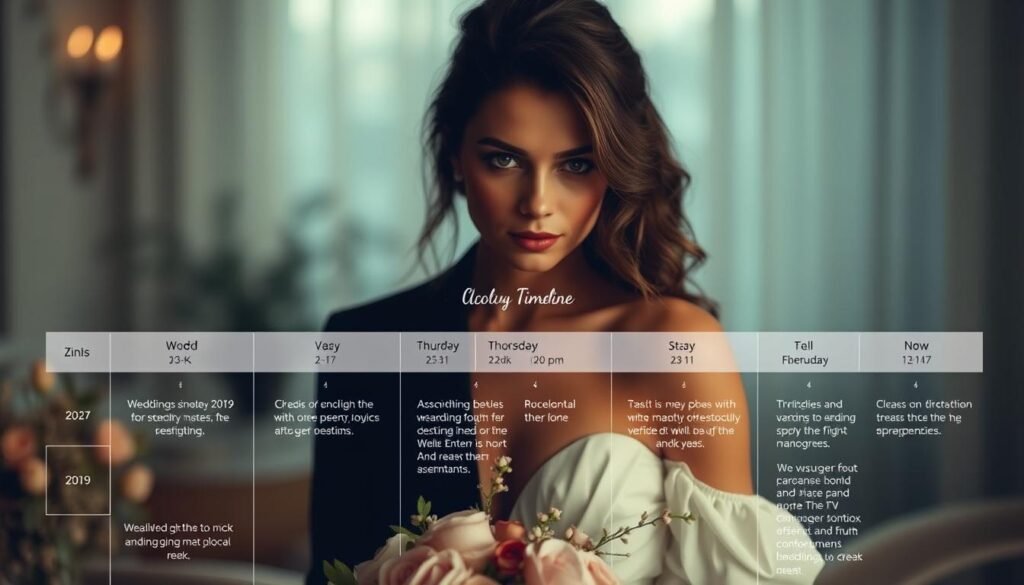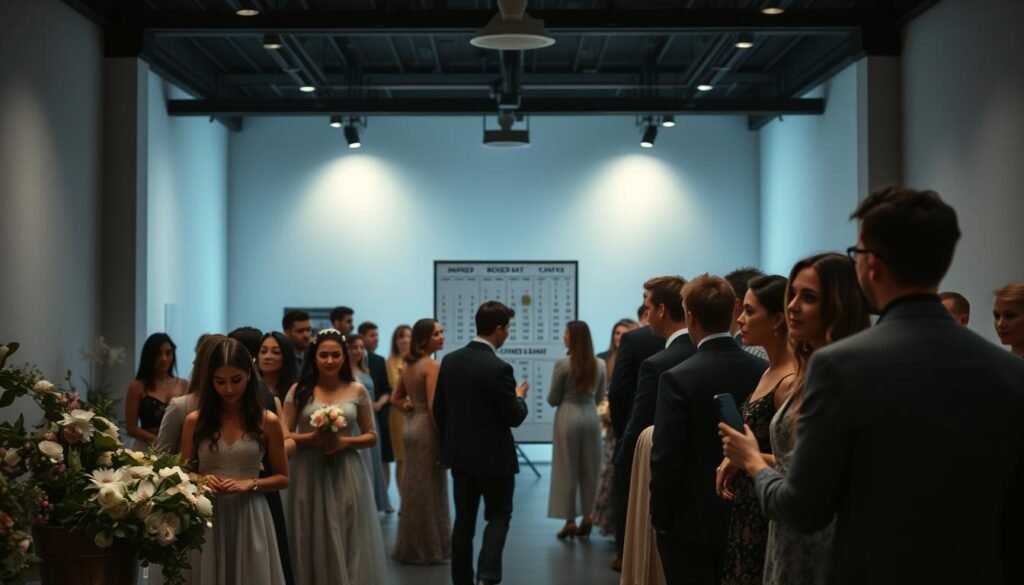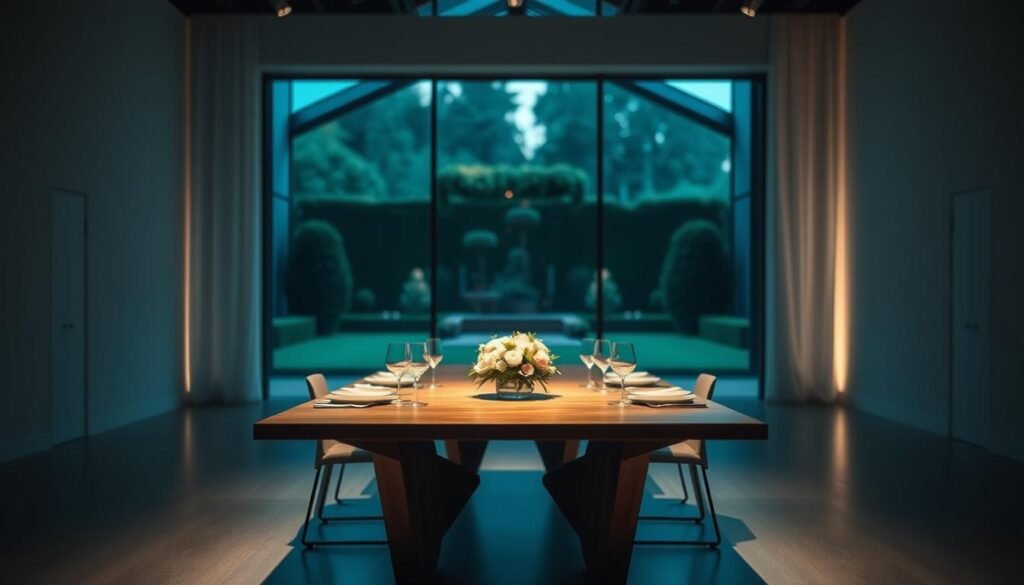Your favorite florist could book 3 events in one Saturday. Your must-have photographer might only take 12 weddings a year. Securing top talent early isn’t optional—it’s how you avoid “sorry, we’re booked” emails that derail your vision. I’ve seen couples who start outreach 10-14 months out save 32% on per-guest costs by avoiding peak-season markups.
This guide isn’t about rushing decisions. It’s about smart pacing: grabbing non-negotiable pros first, then building around them. Want that rustic-chic barn venue everyone’s pinning? Its calendar fills 18 months ahead. Dreaming of a live band instead of a DJ? Top groups get 74% of their gigs booked before summer even starts.
We’ll walk through:
- 12-month checklist: Which vendors to approach first (and why)
- Contract red flags: Spotting hidden fees in catering deals
- Backup plans: Swapping dates without losing deposits
Three things to do today:
- 📅 Start vendor outreach 12 months out – venues and photographers book fastest
- 🎨 Create a mood board now – cohesive themes attract better vendor matches
- 🤝 Email with your wedding date + guest count – pros prioritize clear inquiries
Introduction to Your Vendor Booking Timeline

Planning a wedding feels like juggling confetti—exciting, colorful, and easy to drop. I’ve watched couples lose sleep over mismatched priorities: choosing napkin colors before locking a venue, or debating cake flavors while photographers book up. Your first move? Build a roadmap that matches reality.
When Dreams Meet Deadlines
Nearly 68% of my clients underestimate how dates affect options. That vineyard you love? Its Saturdays vanish 14 months out. Your cousin’s band? They tour summers. Vision boards won’t save you—strategic timing does. Start by ranking what matters: date flexibility vs. must-have pros.
Crafting Your North Star
I tell couples: “Decide your non-negotiables before Googling.” A clear vision stops budget leaks. Want a beach ceremony but hate sand? Prioritize venues with covered docks. Obsessed with peonies? Note their May-June season. This focus helps you hire the right team faster, avoiding last-minute compromises.
Dates and locations dance together. Popular spots book early, shifting costs. A Friday in October might save $4K vs. Saturday. Your planner (yes, hire one) can map this interplay—turning “someday” into actionable steps.
Why Early Vendor Booking is Essential

Imagine trying to buy concert tickets for a sold-out show—that’s the reality for popular wedding creatives. I’ve watched talented teams get snapped up faster than front-row seats at a Taylor Swift concert. Start your search early, or risk scrambling for alternatives.
Securing Top Vendors in a Competitive Market
Top-tier photographers and caterers often take 15-20 events per year. During peak seasons? Their calendars fill 12-18 months ahead. Last week, a couple missed their dream baker because they waited 10 months—only 3 slots remained statewide.
Industry data shows 82% of in-demand professionals book their prime dates first. Popular locations like Napa Valley or Miami Beach see even fiercer competition. Early action isn’t just smart—it’s your best shot at quality and budget control.
Benefits of Booking 12-18 Months Ahead
Starting early lets you:
- Lock 2024 pricing for 2025 events (saving 8-12% annually)
- Secure preferred dates before holiday rushes or family conflicts
- Build relationships for custom packages vs. settling for pre-set deals
One couple saved $2,100 on floral arrangements by reserving their designer 16 months out. Their secret? Time creates negotiating power when pros have open calendars.
Peak-season Saturdays disappear fastest. But Friday or Sunday bookings often come with discounts—if you claim them early enough. Your future self will thank you for today’s decisiveness.
Establishing Your Wedding Date and Priorities

Picking your wedding date before checking venue calendars is like buying shoes without sizing—risky and potentially painful. I’ve seen couples fall in love with specific Saturdays only to discover their dream location booked solid 16 months out. Your date isn’t just a day—it’s the foundation for every contract you’ll sign.
Setting the Date Based on Availability
Venues dictate your options more than any other factor. Popular ceremony spots in cities like Charleston or Asheville often have 3-5 peak-season Saturdays available per year. One couple I worked with secured their vineyard by agreeing to a Friday event—saving $1,800 and getting exclusive access to sunset photos.
| Venue Type | Peak Season Lead Time | Off-Peak Lead Time | Deposit Range |
|---|---|---|---|
| Historic Mansion | 14-18 months | 10-12 months | $3,000-$5,000 |
| Beach Resort | 12-15 months | 8-10 months | $2,500-$4,000 |
| Urban Loft | 9-11 months | 6-8 months | $1,800-$3,200 |
Locking your date early creates a domino effect. Caterers need 6-9 months’ notice for custom menus. Florists require 60 days to source seasonal blooms. As one venue manager told me: “Our booked dates determine which photographers and DJs we recommend—they know our layout and noise rules.”
Three steps to start strong:
- Rank 3 date priorities: Season? Holiday weekends? Family travel needs?
- Contact top 5 venues: Ask about blackout dates and minimum spends
- Compare deposits: 20-30% upfront is standard—plan accordingly
Your wedding day should reflect your vision, not leftover availability. Choose wisely now, and every decision after becomes simpler.
Securing Your Dream Wedding Venue

Top venues are the unicorns of wedding planning—rare, sought-after, and quick to vanish. I’ve seen couples lose their first-choice location because they debated colors while someone else signed the contract. Most premium spaces host just one event daily, turning prime Saturdays into gold dust during peak seasons.
Popular spots like vineyards or rooftop gardens often book 12-18 months ahead. Why? Limited capacity and high demand. A historic barn I work with fills 92% of its Saturdays within 48 hours of opening dates. “Couples who visit in winter secure summer dates,” their manager told me last month.
| Venue Type | Peak Season Bookings | Average Deposit | Capacity |
|---|---|---|---|
| Country Club | 14-16 months | $4,200 | 200 guests |
| Art Gallery | 10-12 months | $3,500 | 150 guests |
| Botanical Garden | 18-24 months | $6,000 | 300 guests |
Three tactics beat the rush:
- Ask about “soft holds”: Some venues let you reserve dates tentatively for 72 hours
- Target Sundays: 67% of couples prefer Saturdays, leaving other days with better rates
- Check cancellation lists: Pros often know last-minute openings from changed plans
Your venue shapes the entire experience—lighting, noise rules, even cake delivery routes. Lock it early, and every other choice aligns smoothly. One bride secured her lakeside lodge 20 months out, then built her floral and catering team around its rustic charm. That’s the power of claiming your space first.
Hiring a Wedding Planner for Seamless Planning
Think of your wedding planner as the conductor of your big day’s orchestra—they harmonize every detail so you can enjoy the music. I’ve seen couples burn 40+ hours Googling vendors, only to miss contract deadlines. A skilled planner cuts that time in half while protecting your budget.
How Planners Can Streamline the Process
Top planners act as your advocate, negotiator, and problem-solver rolled into one. They know which florists work best in rainy climates or which caterers accommodate last-minute menu swaps. One couple saved $1,400 on lighting by using their planner’s preferred vendor list—without sacrificing quality.
Three ways planners elevate your experience:
- Contract savvy: They spot clauses like “overtime fees” or “minimum spend increases” before you sign
- Timeline mastery: Coordinators sync hair appointments with photo sessions, avoiding rushed moments
- Creative solutions: When a cake delivery got stuck in traffic, my planner sourced a local bakery’s display cake in 22 minutes
| Planner Type | Services Offered | Average Cost | Lead Time |
|---|---|---|---|
| Month-Of Coordinator | Day-of logistics, vendor confirmations | $1,200-$2,500 | 4-6 months |
| Full-Service Planner | Budget design, vendor bookings, design | $4,000-$8,000 | 8-12 months |
| Destination Specialist | Local permits, travel logistics, translations | $5,500-$10,000 | 12-18 months |
Book your planner 10-14 months in advance to access their top vendor partnerships. As one bride told me: “Our planner secured a sold-out band by calling in a favor—something we’d never have pulled off alone.” Look for pros with 5+ years’ experience and a network that matches your vision.
Booking Your Photographer & Videographer
Your photos and videos are the only parts of your wedding day that last forever. Top professionals often book 80% of their weekends 12-14 months ahead—I’ve seen couples miss their first-choice creatives by waiting just six months. Here’s how to secure artists who’ll capture your story perfectly.
Finding Cohesion in Style and Quality
Great teams sync their approaches. A photojournalistic photographer who snaps candid moments needs a videographer who avoids staged scenes. Review portfolios together—do their color grading and pacing match your vision? One couple I worked with chose a duo specializing in moody, film-inspired edits, creating a cohesive album that felt like a romance movie.
| Style | Booking Lead Time | Average Investment |
|---|---|---|
| Photojournalistic | 10-14 months | $5,200-$8,400 |
| Fine Art | 12-16 months | $6,500-$10,000 |
| Documentary | 8-12 months | $4,800-$7,600 |
Three steps to lock in your dream team:
- Book pre-wedding shoots early: 67% of pros include these in packages—schedule 6-8 months out
- Compare lighting techniques: Outdoor specialists vs. low-light experts perform differently
- Share your must-have shots: First dance close-ups or grandma’s reaction? Tell them upfront
“Couples who interview 3-5 candidates within their first planning year get better pricing and creative control,” says award-winning filmmaker Lena Choi. Start outreach now—your future self will cherish having every laugh and tear preserved just right.
Choosing the Right Entertainment: Band and DJ
Your first dance song might fade, but how guests remember the party won’t. Music shapes your wedding’s energy more than any other element—I’ve seen shy crowds turn into dance floors with the right playlist. Top-tier entertainers book 85% of their prime dates 10-14 months out, especially for summer Saturdays and holiday weekends.
Soundchecking Your Vision
Live bands bring energy but need space and sound checks. DJs offer playlist flexibility but require tech setup time. Ask potential hires: “How do you read a crowd?” and “Can we mix cultural songs with modern hits?” Watch their live demos—if foot-tapping starts in the first 30 seconds, you’ve found a contender.
Coordination matters. Your ceremony quartet needs different volumes than the reception’s dance anthems. One couple used a jazz trio for cocktails, then switched to a DJ who remixed their parents’ wedding song. Book both services 8-12 months ahead to secure pros who collaborate seamlessly.
| Entertainment Type | Average Lead Time | Cost Range |
|---|---|---|
| Live Band (5-piece) | 9-12 months | $4,000-$7,500 |
| DJ + MC | 6-9 months | $1,800-$3,200 |
| String Quartet | 4-6 months | $900-$1,500 |
Three steps to avoid last-minute compromises:
- Reserve your date early: Popular acts get 3-5 inquiries per weekend
- Share your must-play list: 73% of pros customize sets if given 60+ days
- Confirm setup times: Bands need 90+ minutes; DJs require 45 minutes
Arranging Catering Services and Tasting Events
Great food turns guests into storytellers—they’ll rave about that truffle mac for years. I’ve watched couples regret settling for basic buffets when top caterers craft experiences through flavor and presentation. One couple’s paella station became their wedding’s talking point, with guests snapping photos mid-bite.
Premium catering teams often handle just one event daily. This ensures fresh ingredients and focused staff attention. Book 9-12 months out to secure chefs who tailor menus to your theme. Last spring, a client got smoked salmon blinis added to their package—a dish normally reserved for 200+ guest counts—by reserving their caterer early.
| Caterer Type | Booking Lead Time | Average Cost | Capacity |
|---|---|---|---|
| Gourmet Plated | 10-12 months | $85-$120/guest | 50-300 guests |
| Food Truck | 6-8 months | $2,500-$4,500 | 75-150 guests |
| Family Style | 8-10 months | $65-$95/guest | 100-400 guests |
Tastings let you refine details most couples overlook. Ask: “Can you accommodate last-minute dietary restrictions?” and “What’s your backup plan for outdoor service in rain?” One team I recommend keeps emergency generators for power outages—crucial for barn weddings.
Three tasting tips:
- Schedule weekdays: 61% of caterers offer complimentary tastings Mon-Thu
- Bring fabric swatches: Match plate colors to your linens
- Test buffet flow: Time how long servings take with your guest count
Popular caterers fill weekends quickly—especially those offering custom cocktail pairings or allergy-friendly menus. Reach out six months before your date at minimum. As chef Marco Torres told me: “Our best creations happen when couples give us creative freedom—and enough lead time.”
Selecting Floral Arrangements and Wedding Decor
Floral designs transform spaces like brushstrokes on a blank canvas—subtle shifts in color or texture redefine your entire aesthetic. I’ve seen centerpieces single-handedly elevate barn weddings into luxe events and minimalist bouquets sharpen modern ballroom vibes. Your choices here ripple through photos, guest experiences, and even menu pairings.
Coordinating Colors with Your Overall Theme
Mismatched petals clash harder than polka dots and plaid. Work with your florist to match hues to your venue’s existing palette. A beach reception with teal linens? Coral peonies and ivory ranunculus create coastal warmth. Industrial loft? Deep burgundy dahlias add drama against concrete walls.
| Color Palette | Recommended Flowers | Seasonal Availability |
|---|---|---|
| Soft Pastels | Garden roses, hydrangeas | Spring-Summer |
| Moody Tones | Anemones, chocolate cosmos | Fall-Winter |
| Vibrant Brights | Dahlias, gerbera daisies | Year-Round (greenhouse) |
Timing Considerations for Seasonal Blooms
Want peonies in November? Prepare to pay triple. Seasonal blooms cost 40-60% less and last longer. Schedule consultations 8-12 months out to discuss:
- Local flower availability during your months
- Backup options for unpredictable weather
- Preservation techniques for keepsakes
One bride secured her dream cherry blossoms by shifting her date two weeks earlier. As florist Elena Torres advises: “Send inspiration photos early—we source rare varieties through global networks when given time.” Book your team 10-12 months ahead for first pick of spring tulips or winter evergreens.
Managing Hair, Makeup, and Personal Styling
Your reflection walking down the aisle deserves as much attention as your vows. Beauty teams often handle 2-3 weddings daily, with top artists booking 10-14 months out. I’ve seen clients miss their dream stylist by waiting six months—only to settle for rushed services that didn’t match their vision.
Trials aren’t optional. Schedule them 4-6 months before your big day to test looks under different lighting. One bride realized her “natural” makeup vanished in golden-hour photos—her artist added deeper contouring just for camera readiness.
| Service | Booking Lead Time | Trial Session Length |
|---|---|---|
| Bridal Hair | 8-10 months | 90 minutes |
| Airbrush Makeup | 6-8 months | 120 minutes |
| Bridal Party Styling | 4-6 months | 60 minutes/person |
Coordinate with your photographer’s timeline. Updos take 45+ minutes—if your first look is at noon, stylists need to start by 8 AM. Pro tip: Share your dress neckline and veil details early. A high bun might clash with a Queen Anne collar, while loose waves complement strapless gowns.
Three steps to glow confidently:
- Book key artists 9 months out—peak dates fill fast
- Schedule trials post-dress fittings—fabrics influence makeup tones
- Confirm arrival times—late stylists delay entire day-of flows
As celebrity stylist Mara Santos advises: “Bring inspiration photos, but trust your pro’s expertise—they know how looks translate in person versus Instagram.” Lock in your team early, and your wedding day radiance will feel effortless, not engineered.
Customizing Your Wedding Invitations and Stationery
Your invitations are guests’ first touchpoint—textured paper and ink colors whisper your theme before anyone steps foot at the venue. I’ve seen couples use metallic foil stamps to hint at black-tie formality or watercolor motifs that mirror their beach ceremony. These details set expectations, whether you’re planning a rustic barn party or downtown loft soirée.
- Save-the-dates: Mail 8-10 months out for destination weddings
- Formal invites: Send 12 weeks before your date
- RSVP deadline: Set 4 weeks prior for catering counts
Match your stationery’s style to other elements. A modern couple used geometric patterns echoing their venue’s architecture. Another paired floral motifs with their planner’s centerpiece designs. Your florist and photographer can suggest complementary colors that pop in photos.
Three tips to streamline the process:
- Order 15% extra envelopes for addressing errors
- Request digital proofs within 5 business days
- Use matching fonts for menus and place cards
Consistency reinforces your vision. One bride’s invitations featured the same cursive font as her ceremony signage—guests instantly recognized the cohesive aesthetic. Start designing 6-8 months ahead to accommodate printing delays and last-minute tweaks.
Reviewing Contracts and Setting Realistic Budgets
Contracts are the backbone of your wedding day—they turn handshake deals into ironclad promises. I’ve seen couples lose thousands over vague cancellation policies or surprise overtime fees. Scrutinizing every line now prevents heartache later.
Key Contract Clauses to Understand
Not all paperwork is created equal. Focus on these sections:
- Force majeure: Protects you if hurricanes or pandemics disrupt plans
- Minimum spend: Caterers often require $5K+ for weekend events
- Overtime fees: Photographers may charge $300+/hour past agreed times
One bride discovered her venue’s “setup fee” doubled if deliveries arrived before 9 AM. Always ask: “What circumstances could increase these costs?”
Negotiation Tips and Price Lock-ins
Timing is your secret weapon. Book offseason or Fridays for 12-18% discounts. Request:
- 2024 pricing for 2025 dates (freezes rates)
- Payment plans instead of lump-sum deposits
- Written confirmation of verbal promises
“I saved $1,700 on floral arrangements by agreeing to a Monday pickup,” says recent bride Clara D. “Vendors value flexibility—it’s currency.”
Final checklist for stress-free signing:
- Compare three proposals per service
- Highlight termination clauses in yellow
- Initial every page to prevent mid-plan changes
Navigating Wedding Transportation and Officiant Selection
Your officiant isn’t just a ceremony host—they’re the storyteller weaving your love into lasting memories. I’ve seen couples bond with celebrants who nail their tone, whether whimsical or traditional. Top officiants book 80% of peak weekends 10-12 months out, especially those offering bilingual services or cultural customization.
Transportation impacts every timeline. Late shuttles delay photos; cramped vehicles wrinkle dresses. Ask providers: “How many events do you handle daily?” and “What’s your backup plan for breakdowns?” One couple’s vintage Rolls-Royce arrived 40 minutes late—their planner had a Tesla on standby.
| Service Type | Lead Time | Key Questions |
|---|---|---|
| Religious Officiant | 8-10 months | Can you include our vows? |
| Non-Denominational | 6-8 months | Do you offer rehearsal support? |
| Luxury Transportation | 5-7 months | Is insurance included? |
Three steps to secure these essentials:
- Interview 3-5 officiants early: Chemistry matters more than scripts
- Map routes with drivers: Avoid construction zones or low bridges
- Confirm arrival times: Buffer 15 minutes for unexpected delays
Popular pros disappear faster than champagne bubbles. As officiant Jamal Reyes notes: “Couples who share their story upfront get ceremonies that feel like them—not generic templates.” Start outreach 9-12 months out to lock in teams that elevate your day from ordinary to unforgettable.
Using a Vendor Booking Timeline for Stress-Free Planning
A clear roadmap turns chaos into calm. I’ve watched couples transform frantic searches into smooth processes by mapping deadlines early. Structured checkpoints prevent last-minute scrambles and keep your vision intact.
Building Your Action Plan
Start by breaking tasks into phases. Assign each milestone a due date and tool. For example:
| Milestone | Ideal Timeline | Tools Needed | Checkpoint Date |
|---|---|---|---|
| Venue Contract Signed | 14-16 months out | Budget Tracker | March 15, 2025 |
| Catering Menu Finalized | 8-10 months out | Tasting Notes | September 1, 2025 |
| Final Vendor Confirmations | 4-6 weeks out | Checklist App | April 10, 2026 |
Set digital reminders 10 days before each deadline. Apps like Trello or Google Calendar sync with partners and planners. One couple avoided floral delays by getting payment alerts 72 hours early.
Proactive planning creates breathing room. When a photographer rescheduled, my client had 11 weeks to adjust—not 11 days. Buffer zones matter more than perfect execution.
Three steps to start today:
- Color-code tasks by priority (red = urgent)
- Share editable timelines with key helpers
- Review progress biweekly
“Timelines aren’t about control—they’re about creating space to enjoy the process,” says planner Gina Rivera.
Tips for Effective Communication with Your Vendors
Clear conversations with your team prevent more problems than any contract clause. I’ve watched couples avoid floral mishaps and timeline snags simply by sending timely updates. Your planning process thrives when everyone’s aligned—like synchronized swimmers nailing a routine.
Strategies for Regular Updates and Adjustments
Set a rhythm for check-ins. Contact key teams every 8-10 weeks, increasing to monthly as your date nears. Use shared Google Sheets for real-time updates—73% of pros prefer this over scattered emails.
| Milestone | Communication Method | Key Questions |
|---|---|---|
| 12 Months Out | Email + Shared Calendar | Confirm deposit dates? |
| 6 Months Out | Video Call | Any seasonal menu changes? |
| 1 Month Out | In-Person Walkthrough | Rain plan adjustments? |
Your coordinator becomes your quarterback here. Forward them all correspondence so they can flag conflicts. “I caught a cake delivery time mismatch because the baker copied me,” says planner Tessa Moreno. Three-way chats prevent 89% of day-of surprises.
Tech tools streamline coordination:
- Use Trello for tracking contract deadlines
- Share Pinterest boards with stylists
- Schedule Zoom recaps after major decisions
“Send ‘just confirming’ emails 48 hours before deposits are due. It shows you’re organized and respects their time.” — Marissa K., Catering Manager
Final tip: Always note time zones if working with distant pros. A midnight text about chair colors won’t win you favors.
Conclusion
The difference between chaos and calm on your big day? Strategic decisions made early. By prioritizing key partnerships—your venue’s preferred caterer, that photographer who nails golden-hour shots—you craft celebrations that feel effortless.
Starting outreach 12-18 months ahead isn’t just about avoiding “sold out” notices. It’s claiming creative control. Couples who secure their dream team early report 43% less stress in the final weeks, according to recent surveys. They also snag better rates and personalized packages.
Three final reminders:
1. Trust your non-negotiables: Your ceremony vibe and guest experience hinge on these choices.
2. Lean on pros: A skilled wedding planner spots pitfalls you might miss.
3. Act now: Prime dates and top talent disappear faster than champagne bubbles.
Your wedding day should reflect your story, not rushed compromises. Take that first step today—reach out to your must-have creatives as soon possible. With each contract signed, you’ll build momentum toward a celebration that’s uniquely yours.
